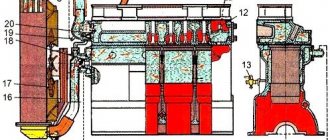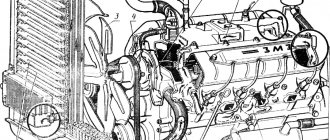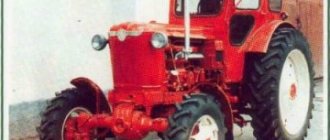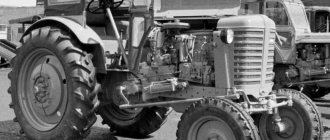Frequent malfunctions of the Yamz 238 engine
Let's consider cases when the engine does not start, or starts with difficulty. If the engine does not start, you need to check the presence of fuel in the tanks. If not, fill the tanks with fuel and bleed the fuel system to remove air from it. The pumping is done by a fuel booster pump. Before pumping, unscrew the air bleed plug on the engine.
Pumping is carried out until the fuel begins to come out without air bubbles. The diesel fuel used for the engine must be in accordance with GOST 4749-49. The use of sulfur fuel (GOST 305-62) in engine operation is allowed, but it is necessary to use diesel oil with the VNII NP-360 -6% additive. In winter, Dz and Z fuel is used, and in summer, DL or L. At very low temperatures, it is recommended to use YES or A fuel.
It is advisable to use Dp-8 oil in winter. Dp-11 is used in the summer using additives VNII NP-360 or CIATIM-339.
Yamz 238 filling containers
Main indicators of YaMZ-238 filling tanks:
- The volume of the lubrication system is 32 l.
- The volume of the cooling system, excluding the radiator volume, is 20 liters.
- The air filter has a volume of 1.4 liters.
- The volume of the high pressure fuel pump is 0.20 l.
- Regulator, volume 0.10 l.
An unfuelled engine weighs:
- 820-1010 kg, excluding auxiliary equipment;
- 880-1070 kg, including a set of auxiliary equipment;
- 1170-1385 kg including gearbox, clutch and accessories kit.
Engine filling capacity
- volume of the engine lubrication system: 24-32 liters, excluding the oil cooler;
- cooling system volume: 17-20 liters, excluding radiator;
- The air filter has a volume of 1.6-1.4 liters;
- fuel pump, volume 0.15-0.2 liters;
- Regulator volume: 0.15 liters;
- gearbox, volume 5.5 liters;
- the mechanism for remote control of the gearbox has a volume of 0.16 liters.
YaMZ 238 photo selection
Contents: PD 10 repair and installation of the starting engine Launcher PD-10: device Repair of the PD-10 starting engine PD-10 gearbox PD-10 carburetor. The design of the carburetor of the starting engine Cylinder PD-10 PD-10 engines: repair and installation […]
Diesel AM-01 is a six-cylinder water-cooled diesel engine with undivided combustion chambers. The diesel crankcase of a rigid design is equipped with wet type liners. The diesel engine has two heads, each with three […]
Oils for engines without turbocharging (YAMZ-1-97 oil group)
| Oil brand | Standard number | Manufacturer |
| M-10-G2(k) M-8-G2(k) | GOST 8581-78 | OJSC Norsi, OJSC Ryazan Oil Refinery, OJSC Slavneft-Yaroslavnefteorgsintez, OJSC Yaroslavl Oil Refinery named after. Mendeleev", LLC "LUKoil-Volgogradneftepererabotka", OJSC "Angarsk Petrochemical LUKoil-Permnefteorgsintez" |
| GOST 10541-78 | OJSC Norsi, OJSC UfaNeftekhim | |
| TU 0253-011-00151742-95 | JSC "Kremenchug Oil Refinery" | |
| Slavol M-3042U (M-10-G2u) Slavol M-2042U (M-8-G2u) | TU U 13932946.015-96 | NPP "Additives" |
| Lukoil Standard SAE 10W-30, AR SF/CC | TU 0253-072-00148636-95 amended. 1-8 | LLC "LUKoil-Permnefteorgsintez" |
: For engines without turbocharging, it is allowed to use oils of the YaMZ-2-97 - YaMZ-5-06 groups with twice the changeover period.
Diesel engine YaMZ 238 turbo - technical characteristics
This YaMZ 238 turbo diesel engine, despite its outdated design and average technical performance, is quite widespread. Due to the fact that cars with this engine have been produced for a long time, there is still a great demand caused by reliability, high maintainability, and the wide distribution of spare parts for these engines. And in comparison with foreign analogues, YaMZ 238 engines are supplied at a low price. This is why YaMZ 238 engines are installed on new models of equipment. Currently, it has been modernized to comply with Euro-2, -3 standards, and the engine power has been increased to 400 hp.
Engine YaMZ 238
The material from which the cylinder blocks of the YaMZ 238 engine are made is gray cast iron. The cylinder liners are also cast from special cast iron. The engine has two heads, one for each row. There is also a forged steel crankshaft with counterweights. There are also 4-5 crankshaft supports. The engine pistons are made of aluminum alloy. In total, the piston has three compression piston rings and two oil removable ones.
Retaining rings limit the axial movement of the floating piston pins. Also installed are forged steel connecting rods with an oblique lower head connector. To start the engine with a starter, a flywheel with a steel ring gear is used.
Stamped steel pull-out levers (4 pieces), mounted on needle bearings. Between the levers there is a subordinate ratio of 1:5.4. 28 pieces of cylindrical pressure springs twisted from steel wire are installed. The middle drive disk, cast from cast iron, is connected by spikes to the flywheel.
Friction linings are riveted on both sides of the driven disk. It itself is stamped, made of sheet steel. The motor uses a ball thrust thrust bearing, with permanent lubrication. The clutch release clutch is cast from steel and is lubricated through a flexible hose and grease fitting. The housing is bolted on one side to the gearbox housing and on the other side to the flywheel housing.
Overall dimensions of the YaMZ-238 motor
- Length 1020-1222 mm, without clutch and gearbox;
- Length 1796-2069 mm, with clutch and gearbox;
- Width 1006 mm;
- Height 1195 mm.
Correct assembly of Yamz 238
When YaMZ 238 engines are assembled, pre-assembled components and parts are installed on its cylinder block. A sleeve without rubber rings is selected in accordance with the technical conditions so that it is installed with a slight pressure of the hand. The sleeves must be without o-rings and match the height of the collar.
If, upon inspection of the installation locations of the O-rings, they are heavily corroded, they must be cleaned and filled with epoxy resin at the bottom of the block. All units and parts are wiped with a napkin and installed clean. It is not recommended to use textile materials, because their fibers, remaining on the surface, clog the oil channels. If the oil channels are still clogged, they are washed with diesel fuel, after which it must be blown out with compressed air.
Before installation, all parts are pre-selected and adjusted to each other. The driven gear shaft oil seal is installed using a mandrel in the cylinder block. When installing the fuel pump drive, the previously installed oil seal is protected with a mandrel, which is placed on the free end of the shaft. In order for the engine pushers to easily turn on their axes, without jamming, they need to be installed fifth towards the window located in the cylinder block under the pusher rod. The pushers themselves must be wiped and lubricated before assembly.
Before installation in the block, the camshaft must be wiped with a cloth and coated with the oil used for the engine. When installing the timing gears, make sure that the marks on the ends of the gears match. Also, make sure that the gaps between the thrust flange and the end of the shaft journal are normal. In order to install the camshaft, you need to align the installation mark L with the installation mark P.
After installing the camshaft, there should be no binding. When installing the crankshaft into the cylinder block, screw in the cover bolts by hand, one or two threads. Tightening the bolts starts from the middle and ends at the edges. The axial clearance of the crankshaft is adjusted by selecting thrust washers. They are installed on both sides on the front main bearing.
To protect the crankshaft oil seal from damage, you need to place a mandrel on the front end of the crankshaft and lubricate the outer surface with diesel oil.
When installing the coupling half, you need to check the alignment of the “0” marks on the coupling half and the flange. The connection between the automatic clutch and the driven gear shaft half-coupling is made using a textolite washer.
When the main bearings of the YaMZ 238 engine are assembled, the wooden seals are pressed in with a hammer. If the ends of the seals protrude above the parting plane, remove them with a knife. Be sure to lubricate the piston before installing it in the block. First, wipe all working surfaces of the piston, liners, liners, piston rings, and journals with a napkin. Safety tips are pre-installed on the connecting rod bolts. If the engine is assembled correctly, the crankshaft should turn smoothly with a hand lever.
Diesel cooling system YaMZ-236 and its parts
The cooling system of the YaMZ-236 engine of the Ural, Maz, and T-150 tractors is liquid, circulating. The cooling system includes a water pump, fan, thermostats, remote thermometer and a radiator mounted on the machine frame. During operation of the YaMZ-236 engine of Ural and Maz vehicles and the T-150 tractor, the circulation of coolant in the cooling system is created by a centrifugal pump. From the discharge pipe of the pump, through the channels in the cover of the distribution gears, liquid under pressure enters the water jacket of the left row of cylinders and the right row of the cylinder block, then into the cylinder heads and is collected in the drainage pipelines.
Liquid is supplied to the water jackets of the cylinder heads through guide channels, primarily to the most heated surfaces - exhaust pipes and injector cups.
From the drainage pipelines, the heated liquid is supplied through thermostats to the radiator, where it gives off heat to the air flow created by the fan, after which it again goes to the YaMZ-236 water pump.
When coolant temperature drops, thermostats automatically direct all coolant flow directly to the water pump, bypassing the radiator. Thus, through thermostats, the optimal thermal operating conditions of the engine are ensured.
The YaMZ-236 water pump is of centrifugal type, installed in the front part of the engine of Ural, Maz cars, and T-150 tractors and driven by a V-belt from a pulley mounted at the front end of the crankshaft.
An impeller, pressed onto a roller, rotates in a cast iron housing. The pump shaft is mounted on two ball bearings with a one-way seal. When assembling the pump, the bearing cavity is filled with Litol lubricant for the entire service life of the pump without additional lubrication.
The pump cavity is sealed along the end surfaces. To monitor the tightness of the mechanical seal, there is a drainage hole in the pump housing.
The water pumps installed on YaMZ-236 engines have significant design differences and are not interchangeable with each other:
— The water pump of YaMZ-236N,B engines (Fig. 1) is marked on the housing 236-1307010-A3. — The water pump of the YaMZ-236NE,NE2,BE,BE2 engines is marked on the housing 236-1307010-B1.
Rice. 1 — Water pump of the YaMZ-236 engine.
1 – body; 2 – nipple; 3 – roller; 4 – ball bearings; 5 – retaining ring; 6 – bushing; 7 – pulley; 8,10 – nuts; 9 – lock washer; 11 – adjusting gasket; 12 – hairpin; 13 – water dispenser; 14 – body bushing; 15 – retaining ring; 16 – thrust ring; 17 – sealing ring; 18 – impeller fastening nut; 19 – oil seal cuff; 20 – spring; 21 – impeller; 22 – housing cover.
Maintenance of the YaMZ-236 diesel cooling system
The efficiency, reliability, service life and other indicators of the engine largely depend on the proper operation of the YaMZ-236 engine cooling system of the Ural, Maz, and T-150 tractors.
To ensure normal engine operation, fulfill the following requirements:
Fill the YaMZ-236 engine cooling system with recommended special low-freezing liquids or, in exceptional cases, for a short time with clean soft water.
Pour coolant through a funnel with a mesh using clean containers.
Monitor the coolant temperature, maintaining it within 75 – 90ºС.
To avoid the occurrence of deformations of the heads and jacket of the cylinder block, add coolant to the cooling system of a warm engine gradually and always during operation.
If the cooling system of the YaMZ-236 engine of the Ural, Maz, or T-150 tractors is filled with water, then regularly flush the cooling system with clean water using a special flushing gun, and if it is not available, with a strong stream of clean water, preferably pulsating. Systematically remove scale from the cooling system.
When using antifreeze as a coolant, it is necessary to periodically monitor its color. If antifreeze acquires a red-brown color, this indicates its aggressiveness towards the structural materials of engine parts.
In this case, the antifreeze must be replaced, having first flushed the cooling system.
Monitor the serviceability of the mechanical seal of the water pump impeller, keeping in mind that coolant leaking into the water pump bearings damages them.
A faulty mechanical seal is indicated by water leaking from the drainage hole on the water pump housing, which must not be plugged. A pump with a faulty seal must be repaired.
In case of temperature violation, check the serviceability of thermostats and their gaskets.
The starting temperature of the main thermostat valve should be 80±2ºС (indicated on the thermostat body). The valve must open completely, moving at least 8 mm from its seat. Replace the faulty thermostat with a new one.
Water pump for YaMZ-236 engines - disassembly and assembly
Features of disassembling and assembling a water pump installed on YaMZ-236 engines of Ural and Maz vehicles, and the T-150 tractor.
Rice. 2 — Water pump of the YaMZ-236 engine.
1–body; 2–impeller; 3-face seal; 4–bushing; 5– shaft; 6–water release; 7–plug; 8–supply pipe; 9–circlip; 10–pulley; 11, 12 – sealing rings; 13–bearings; 14, 15 – fastening nuts and spring washers.
Dismantling the water pump (pump) YaMZ-236
Having loosened the fastening of the YaMZ-236 water pump (pump) drive belt tensioner, remove the belt from the water pump pulley.
Drain the engine and radiator coolant.
Remove the inlet pipe from the water pump.
After unscrewing the fastener, remove the water pump from the engine, being careful not to damage the gasket.
Unscrew nuts 14 (Fig. 2) of pipe 8.
Lightly tapping the protruding parts of pipe 8 in the direction of arrows B, remove the said pipe from pump housing 1.
Secure impeller 2 (or pulley 10) from rotation with shaft 5.
Unscrew plug 7 from the threaded hole of the impeller 2.
Screw the nut 17 of the puller into the threaded hole (M22x1.5) of the impeller 2 and, screwing in the bolt 18, press the impeller 2 from the shaft 5.
Bend the “whiskers” D of the mechanical seal housing 19 and remove the cuff 22 with the spring and frames assembled.
Using a puller, press pulley 10.
Remove retaining ring 9 from the groove of pump housing 1.
Press shaft 5 with water release valve 6 and bearings 13 out of the housing.
If the brass housing 23 of the mechanical seal is not damaged, it can not be removed from the housing 1 and disassembly of the pump can be considered complete.
Assembly of the YaMZ-236 pump
Wash all parts of the water pump of the YaMZ-236 engine of the Ural, Maz, and T-150 tractors and dry with compressed air.
Press bearings 13 and water dispenser 6 onto shaft 5 (Fig. 2).
In this case it is necessary:
− pre-lubricate shaft 5 with diesel oil; − install bearings 13 so that the sealing washers are on the outside; − apply pressing force to the inner ring of the bearing.
Rice. 3 — Dismantling the YaMZ-236 water pump.
2–impeller; 9–circlip; 10–pulley; 17 – puller nut; 18–bolt puller; 19–mechanical seal housing; 20 – sleeve cuff; 21–seal bushing; 22–cuff with spring assembly.
Fill the entire cavity between the bearings with Litol lubricant (60...70 g).
Press the shaft assembly with bearings and water release into housing 1 until it stops.
In this case it is necessary:
− pre-lubricate the housing bore 1 for the bearings with clean engine oil; − apply pressing force to the outer ring of the bearing.
Install retaining spring ring 9 into the groove of the water pump housing of the YaMZ-236 engine. Press pulley 10 onto shaft 5 until it stops.
In this case it is necessary:
− pre-lubricate the shaft with clean engine oil; − provide a fixed stop for the opposite end of the shaft.
Install the parts of the mechanical seal of the YaMZ-236 pump into the brass body 19 (Fig. 3);
− rubber cuff 22 assembled with a spring and spring frames; − reinforced cuff 20 and sealing sleeve 21. Install rubber cuff 23 and sealing sleeve 21 into impeller 2.
In this case it is necessary:
− first place the cuff 23 on the sealing sleeve 21; − apply a thin layer of lubricant into the bore of the impeller 2 and onto the outer surface of the rubber cuff 23; − take the cuff assembly with the bushing with both hands and, applying force to the end of the sealing bushing, insert these parts into the impeller bore until it stops, avoiding distortions.
Press the impeller of the YaMZ-236 engine pump assembly with the cuff and sealing sleeve onto shaft 5 (Fig. 2).
In this case it is necessary:
− pre-lubricate shaft 5 with clean engine oil; − provide a fixed stop for the opposite end of the shaft; − install the impeller on the shaft at a size of 10-0.15 mm (Fig. 2) between the end of the shaft and the end of the impeller hub. To do this, when pressing, it is necessary to install a disk with a diameter of no more than 13 mm and a height of 10-0.15 mm on the end of the shaft.
Secure impeller 2 (or pulley 10) from rotation. Screw plug 7 into the threaded hole of the impeller 2 until it stops;
Install 1 bushing 4 and rubber ring 12 into the body.
Install rubber ring 11 into the groove of pipe 3, preventing it from twisting.
Press pipe 3 into the bore of body 1 until it stops.
In this case it is necessary:
− pre-lubricate the bore in body 1 and ring 11 with a thin layer of Litol lubricant; − the studs on body 1 must fit freely into the mounting holes of pipe 8.
Secure the pipe with 3 nuts 14 and spring washers 15.
Check the quality of assembly by rotating shaft 5 by pulley 10. The rotation of the shaft should be free, without jamming.
All necessary parts can be purchased in our catalog
Features of changing oil in the rear axle gearbox
Transmission oil needs to be changed every 35 thousand km. mileage This is the main requirement for a MAZ truck, which is operated under heavy load conditions. It is important to regularly check the level as well as the condition.
If the oil drops below the recommended value, it must be replaced. Other factors can be identified that indicate deterioration in the characteristics of the lubricant:
- presence of silver dust;
- presence of metal particles;
- the oil acquired a black, dark gray, coffee tint.
These signs indicate that water has entered the oil or additives that perform important functions have been destroyed. The transmission oil in the rear axle gearbox is changed immediately after the trip so that it is warmed up. All work must be carried out on an inspection pit or a spacious overpass.
To fill the rear axle gearbox with oil, it is recommended to use a special supercharger or lever grease fitting. These devices can be purchased at specialized automotive stores. They are replaced with a large plastic syringe, on which an elastic tube is placed and tightly fixed. It is recommended to carry out work on changing the oil in the rear axle gearbox in the summer.
The MAZ rear axle gearbox is designed to reduce the speed in the transmission, as well as transmit torque to each drive wheel. The differential is located in the gearbox housing. It is responsible for the proportions of torque distribution.
Technical features of engines YaMZ-236, YaMZ-238
Of course, other technical characteristics also play a role in the effective operation of the motors under consideration, so it makes sense to dwell on them:
- type – diesel and turbodiesel (YaMZ 238e);
- number of cylinders. YaMZ 236 – 6-cylinder, YaMZ 238 – 8-cylinder;
- arrangement of cylinders. In YaMZ 236 – V-shaped, in YaMZ 238 – U-shaped;
- horsepower - from 180 to 240;
- fuel injection - direct type;
- cooling - due to special liquids;
- modification of models - atmospheric and turbocharged;
- mileage life – from 800 thousand km to 1,000,000 km.
All these points are very important to take into account.











